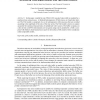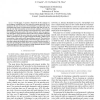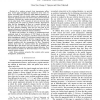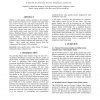100
Voted
VCIP
2000
15 years 2 months ago
2000
An alternative method to H.263 for encoding of moving images at bit rates below 64 kbit/s is presented using adaptive spatial subsampling, mesh based interpolation and node tracki...
78
Voted
PICS
2001
15 years 2 months ago
2001
A first television system based on the Autosophy information theory is now being tested. The new television marks a major theoretical break from conventional television based on t...
122
click to vote
LCN
2000
IEEE
15 years 5 months ago
2000
IEEE
In this paper, variable bit rate (VBR) H.261 encoded video traffic is modeled by a nonlinear time series process. A threshold autoregressive (TAR) process is of particular interes...
ICC
2000
IEEE
15 years 5 months ago
2000
IEEE
— In this paper, we present a framework for the analysis of a set of adaptive variable-bit-rate voice sources in a packet network. The instantaneous bit rate of each source is de...
117
click to vote
ICPP
2002
IEEE
15 years 5 months ago
2002
IEEE
A cost-effective approach to building up scalable Videoon-Demand (VoD) servers is to couple a number of VoD servers together in a cluster. In this article, we study a crucial vide...
103
click to vote
VLBV
2005
Springer
15 years 6 months ago
2005
Springer
We vary the quantization parameter in H.264 video encoding by increasing it by a well-chosen offset in every other frame, which we call reduced frames. As the motion compensation ...
120
Voted
VTC
2006
IEEE
15 years 6 months ago
2006
IEEE
— Wireless local area networks offer a range of transmitted data rates that are to be selected according to estimated channel conditions. However, due to packet overheads and con...
102
click to vote
ISCAS
2007
IEEE
15 years 7 months ago
2007
IEEE
—In this paper, we investigate image compression using 2D Dual-tree Discrete Wavelet Transform (DDWT), which is an overcomplete transform with direction-selective basis functions...
113
click to vote
ICC
2007
IEEE
15 years 7 months ago
2007
IEEE
—In a wireless network, data transmission suffers from varied signal strengths and channel bit error rates. To ensure successful packet reception under different channel conditio...
105
click to vote
ICASSP
2007
IEEE
15 years 7 months ago
2007
IEEE
Objective video quality metrics reported in the literature have so far been focused on TV signals with large frame sizes, full TV frame rates, and high compressed bit rates. The a...




